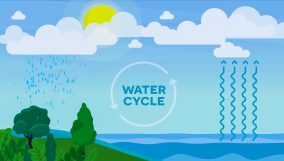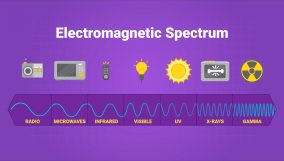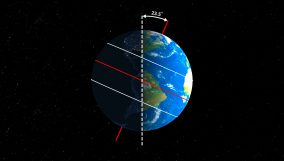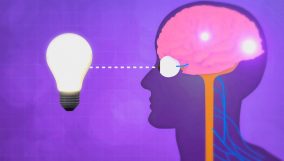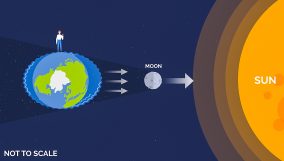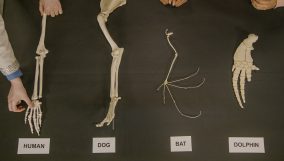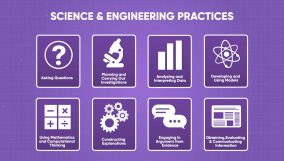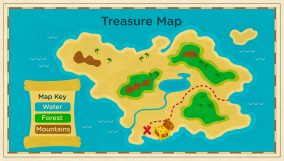Newton’s 3rd Law Of Motion Definition
Newton's 3rd Law of Motion states that for every action, there's an equal and opposite reaction. For example, a rocket moves upwards as gases are expelled downwards.
View Lesson on Newton’s Laws of Motion
Become a member to get full access to our entire library of learning videos, reading material, quiz games, simple DIY activities & more.
Become a member to get full access to our entire library of learning videos, quiz games, & more.
Plans & Pricingto watch this full video.

Access All Videos
and Lessons, No Limits.
Access All Videos

No credit card required,
takes 7 sec to signup.
No card required

Ready-to-go lessons
that save you time.
Ready-to-go lessons
If you are on a school computer or network, ask your tech person to whitelist these URLs:
*.wistia.com, fast.wistia.com, fast.wistia.net, embedwistia-a.akamaihd.net
Sometimes a simple refresh solves this issue. If you need further help, contact us.
Newton’s Laws of Motion
Fun Facts
- A ball bounces back with an equal force when thrown down.
- When water squirts one way, the hose handle moves the opposite way.
- A balloon moves in the opposite direction of air pushing out.
Why Do We Need To Know About Newton's 3rd Law Of Motion
Newton’s 3rd law of motion tells us that every action has an equal and opposite reaction, which helps us understand how things move together. This idea is important for engineers who design things like rockets and water jets. For example, rockets move up because they push gases out downwards, and water jets, like the ones used in flyboards, work by pushing water out to lift the rider up.
This law is also used to make cars safer. Engineers use it to design airbags and parts of the car that squish to absorb shock in a crash, protecting the people inside. These examples show how Newton’s 3rd law is key to making safe and effective transportation.
Frequently Asked Questions
Check out the Full Lesson on Newton’s Laws of Motion
In this lesson, we learn that:
- Newton's 1st law tells us that an object won't change its motion unless acted upon by a force.
- Newton's 2nd law tells us that heavier objects need a larger force to move them.
- Newton's 3rd law tells us that for every action there is an equal and opposite reaction.
Related Topics
- Amplitude Definition
- Balanced Force Definition
- Chemical Change Definition
- Chemical Reaction Definition
- Comparative Anatomy Definition
- Compound Definition
- Condensation Definition
- Conduction Definition
- Definition Of Shade
- Dichotomous Key Definition
- Endoskeleton Definition
- Energy Conversion Definition
- Environmental Factors Definition
- Fresh Water Definition
- Gas Definition
- Generator Definition
- Gravity Definition
- Humidity Definition
- Landform Definition
- Landslide Definition
- Light Year Definition
- Magnetic Poles Definition
- Material Definition
- Mold Fossils Definition
- Motion Definition
- Newton’s 1st Law Of Motion Definition
- Newton’s 2nd Law Of Motion Definition
- Newton’s 3rd Law Of Motion Definition
- Ocean Current Definition
- Physical Change Definition
- Pollen Definition
- Predation Definition
- Reactants Definition
- Respiratory System Definition
- Sediment Filter Definition
- Seed Definition
- Smelling Definition
- Soil Erosion Definition
- Solar Eclipse Definition
- Solar System Definition
- Sound Wave Definition
- Taxonomy Definition
- Texture Definition
- Unbalanced Force Definition
- Virus Definition
- Wave Definition
- Weight Definition
- Wind Erosion Definition
Start a Free Trial Today. Get a $5 Amazon Gift Card!
Teachers! Start a free trial & we'll send your gift card within 1 day. Only cards left. Try it now.
Select Grade
Select Subject
This email is associated with a Science Kit subscription. Kit subscriptions are managed on this separate page: Manage Subscription

-
Download InvoiceScience & Math$/yr
-
Download InvoiceScience Only$/yr

access all lessons
• No credit card required •
"My students loved the videos. I started the video subscription in May and used them as a review before the state test, which I know contributed to 100% of my class passing the state test."
Rhonda Fox 4th Grade Teacher, Ocala, Florida
• No credit card required •
"My students loved the videos. I started the video subscription in May and used them as a review before the state test, which I know contributed to 100% of my class passing the state test."
Rhonda Fox 4th Grade Teacher, Ocala, Florida
• No credit card required •
Already a member? Sign In
* no credit card required *

* no credit card required *
* no credit card required *


no credit card required
Skip, I will use a 3 day free trial
Enjoy your free 30 days trial
-
Unlimited access to our full library
of videos & lessons for grades K-5. -
You won’t be billed unless you keep your
account open past your 14-day free trial. -
You can cancel anytime in 1 click on the
manage account page or by emailing us.
-
Unlimited access to our full library of videos & lessons for grades K-5.
-
You won't be billed unless you keep your account open past 14 days.
-
You can cancel anytime in 1-click on the manage account page.
Cancel anytime in 1-click on the manage account page before the trial ends and you won't be charged.
Otherwise you will pay just $10 CAD/month for the service as long as your account is open.
Cancel anytime on the manage account page in 1-click and you won't be charged.
Otherwise you will pay $10 CAD/month for the service as long as your account is open.
We just sent you a confirmation email. Enjoy!
DoneWe use cookies to make your experience with this site better. By using this site you agree to our use of cookies. Click "Decline" to delete and block any non-essential cookies for this site on this specific property, device, and browser. Please read our privacy policy for more information on the cookies we use.Learn More
We use cookies to improve your experience. By using this site, you agree to our use of cookies. Click "Decline" to block non-essential cookies. See our privacy policy for details.Learn More























